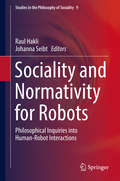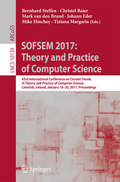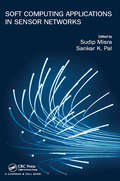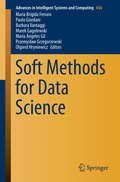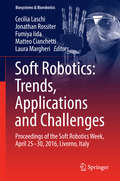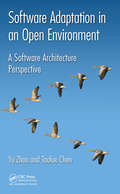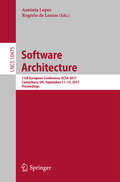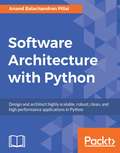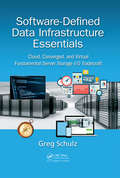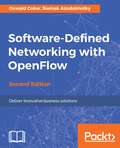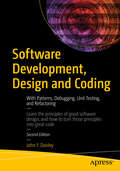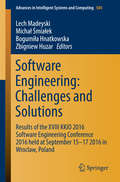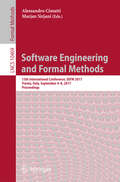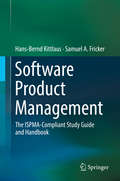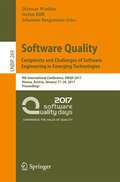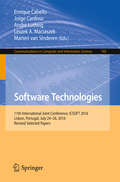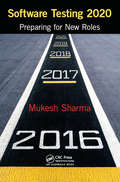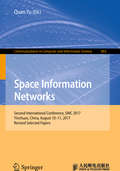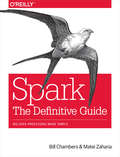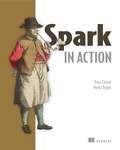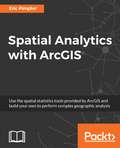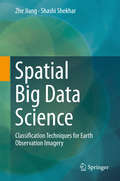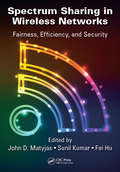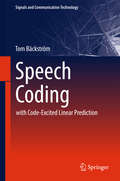- Table View
- List View
Sociality and Normativity for Robots
by Raul Hakli Johanna SeibtThis volume offers eleven philosophical investigations into our future relations with social robots--robots that are specially designed to engage and connect with human beings. The contributors present cutting edge research that examines whether, and on which terms, robots can become members of human societies. Can our relations to robots be said to be "social"? Can robots enter into normative relationships with human beings? How will human social relations change when we interact with robots at work and at home? The authors of this volume explore these questions from the perspective of philosophy, cognitive science, psychology, and robotics. The first three chapters offer a taxonomy for the classification of simulated social interactions, investigate whether human social interactions with robots can be genuine, and discuss the significance of social relations for the formation of human individuality. Subsequent chapters clarify whether robots could be said to actually follow social norms, whether they could live up to the social meaning of care in caregiving professions, and how we will need to program robots so that they can negotiate the conventions of human social space and collaborate with humans. Can we perform joint actions with robots, where both sides need to honour commitments, and how will such new commitments and practices change our regional cultures? The authors connect research in social robotics and empirical studies in Human-Robot Interaction to recent debates in social ontology, social cognition, as well as ethics and philosophy of technology. The book is a response to the challenge that social robotics presents for our traditional conceptions of social interaction, which presuppose such essential capacities as consciousness, intentionality, agency, and normative understanding. The authors develop insightful answers along new interdisciplinary pathways in "robophilosophy," a new research area that will help us to shape the "robot revolution," the distinctive technological change of the beginning 21st century.
SOFSEM 2017: Theory and Practice of Computer Science
by Bernhard Steffen Christel Baier Mark van den Brand Johann Eder Mike Hinchey Tiziana MargariaThis book constitutes the refereed proceedings of the 43rd International Conference on Current Trends in Theory and Practice of Computer Science, SOFSEM 2017, held in Limerick, Ireland, in January 2017. The 34 papers presented in this volume were carefully reviewed and selected from 41 submissions. They were organized in topical sections named: foundations in computer science; semantics, specification and compositionality; theory of mobile and distributed systems; verification and automated system analysis; petri nets, games and relaxed data structures; graph theory and scheduling algorithms; quantum and matrix algorithms; planar and molecular graphs; coloring and vertex covers; algorithms for strings and formal languages; data, information and knowledge engineering; and software engineering: methods, tools, applications.
Soft Computing Applications in Sensor Networks
by Sudip Misra and Sankar K. PalThis book uses tutorials and new material to describe the basic concepts of soft-computing which potentially can be used in real-life sensor network applications. It is organized in a manner that exemplifies the use of an assortment of soft-computing applications for solving different problems in sensor networking. Written by worldwide experts, the chapters provide a balanced mixture of different problems concerning channel access, routing, coverage, localization, lifetime maximization and target tracking using emerging soft-computing applications.
Soft Methods for Data Science
by Maria Brigida Ferraro Paolo Giordani Barbara Vantaggi Marek Gagolewski María Ángeles Gil Przemysław Grzegorzewski Olgierd HryniewiczThis proceedings volume is a collection of peer reviewed papers presented at the 8th International Conference on Soft Methods in Probability and Statistics (SMPS 2016) held in Rome (Italy). The book is dedicated to Data science which aims at developing automated methods to analyze massive amounts of data and to extract knowledge from them. It shows how Data science employs various programming techniques and methods of data wrangling, data visualization, machine learning, probability and statistics. The soft methods proposed in this volume represent a collection of tools in these fields that can also be useful for data science.
Soft Robotics: Trends, Applications and Challenges
by Cecilia Laschi Jonathan Rossiter Fumiya Iida Matteo Cianchetti Laura MargheriThis book offers a comprehensive, timely snapshot of current research, technologies and applications of soft robotics. The different chapters, written by international experts across multiple fields of soft robotics, cover innovative systems and technologies for soft robot legged locomotion, soft robot manipulation, underwater soft robotics, biomimetic soft robotic platforms, plant-inspired soft robots, flying soft robots, soft robotics in surgery, as well as methods for their modeling and control. Based on the results of the second edition of the Soft Robotics Week, held on April 25 30, 2016, in Livorno, Italy, the book reports on the major research lines and novel technologies presented and discussed during the event. "
Software Adaptation in an Open Environment: A Software Architecture Perspective
by Yu Zhou Taolue ChenThe book is about a very active research field in software engineering. In modern society, the fact of the world's high reliance on software requires the system's robustness, i.e., continual availability and satisfactory service quality. This requirement gives rise to the popularity of the research on the self-adaptive software in open environment. There are some academic conferences dedicated to this field. But there is a lack of monographs about the topic. We believe such need is unmet in marketplace. By publishing the book, it can help bridge the gap and bring benefits to readers thereof. Key Features: The topic is well-motivated, interesting and actively studied worldwide The research represents as the state-of-the-art in the field The technical part of the book is rigidly evaluated The theoretical part of the book is sound and proved The organization and presentation of the book will be double-checked by professional scholars
Software Architecture
by Antónia Lopes Rogério De LemosThis book constitutes the proceedings of the 11th European Conference on Software Architecture, ECSA 2017, held in Canterbury, UK, in September 2017. The 9 full papers presented together with 12 short papers and one keynote talk were carefully reviewed and selected from 54 submissions. They are organized in topical sections on Software Architecture Analysis and Verification; Software Architecture Evolution; Automatic Generation; Architectural Decisions; Software Architecture Practice.
Software Architecture with Python
by Anand Balachandran PillaiArchitect and design highly scalable, robust, clean, and highly performant applications in Python About This Book • Identify design issues and make the necessary adjustments to achieve improved performance • Understand practical architectural quality attributes from the perspective of a practicing engineer and architect using Python • Gain knowledge of architectural principles and how they can be used to provide accountability and rationale for architectural decisions Who This Book Is For This book is for experienced Python developers who are aspiring to become the architects of enterprise-grade applications or software architects who would like to leverage Python to create effective blueprints of applications. What You Will Learn • Build programs with the right architectural attributes • Use Enterprise Architectural Patterns to solve scalable problems on the Web • Understand design patterns from a Python perspective • Optimize the performance testing tools in Python • Deploy code in remote environments or on the Cloud using Python • Secure architecture applications in Python In Detail This book starts off by explaining how Python fits into an application architecture. As you move along, you will understand the architecturally significant demands and how to determine them. Later, you'll get a complete understanding of the different architectural quality requirements that help an architect to build a product that satisfies business needs, such as maintainability/reusability, testability, scalability, performance, usability, and security. You will use various techniques such as incorporating DevOps, Continuous Integration, and more to make your application robust. You will understand when and when not to use object orientation in your applications. You will be able to think of the future and design applications that can scale proportionally to the growing business. The focus is on building the business logic based on the business process documentation and which frameworks are to be used when. We also cover some important patterns that are to be taken into account while solving design problems as well as those in relatively new domains such as the Cloud. This book will help you understand the ins and outs of Python so that you can make those critical design decisions that not just live up to but also surpass the expectations of your clients. Style and approach Filled with examples and use cases, this guide takes a no-nonsense approach to help you with everything it takes to become a successful software architect.
Software-Defined Data Infrastructure Essentials: Cloud, Converged, and Virtual Fundamental Server Storage I/O Tradecraft
by Greg SchulzSoftware-Defined Data Infrastructures Essentials provides fundamental coverage of physical, cloud, converged, and virtual server storage I/O networking technologies, trends, tools, techniques, and tradecraft skills. From webscale, software-defined, containers, database, key-value store, cloud, and enterprise to small or medium-size business, the book is filled with techniques, and tips to help develop or refine your server storage I/O hardware, software, and services skills. Whether you are new to data infrastructures or a seasoned pro, you will find this comprehensive reference indispensable for gaining as well as expanding experience with technologies, tools, techniques, and trends. We had a front row seat watching Greg present live in our education workshop seminar sessions for ITC professionals in the Netherlands material that is in this book. We recommend this amazing book to expand your converged and data infrastructure knowledge from beginners to industry veterans. —Gert and Frank Brouwer, Brouwer Storage Consultancy Software-Defined Data Infrastructures Essentials provides the foundational building blocks to improve your craft in serval areas including applications, clouds, legacy, and more. IT professionals, as well as sales professionals and support personnel, stand to gain a great deal by reading this book.—Mark McSherry, Oracle Regional Sales Manager Looking to expand your data infrastructure IQ? From CIOS to operations, sales to engineering, this book is a comprehensive reference, a must read for IT infrastructure professionals, beginners to seasoned experts.—Tom Becchetti, Advisory Systems Engineer Greg Schulz has provided a complete ‘toolkit’ for storage management along with the background and framework for the storage or data infrastructure professional or those aspiring to become one.—Greg Brunton, Experienced Storage and Data Management Professional
Software-Defined Networking with OpenFlow - Second Edition
by Oswald Coker Siamak AzodolmolkyMaster OpenFlow concepts to improve and make your projects efficient with the help of Software-Defined Networking. About This Book • Master the required platforms and tools to build network applications with OpenFlow • Get to grips with the updated OpenFlow and build robust SDN-based solutions • An end-to-end thorough overview of open-source switches, controllers, and tools Who This Book Is For If you are a network/system administrator or a system engineer and would like to implement OpenFlow concepts and take Software-Defined Networking on your projects to the next level, then this book is for you. If you are aware of broad networking concepts, and are familiar with the day-to-day operation of computer networks, you will find this book very beneficial. What You Will Learn • Explore Software-Defined Networking and activities around SDN/OpenFlow including OpenFlow messages • Hardware and software implementations of OpenFlow switches and experiment with Mininet GUI • Learn about the role of OpenFlow in cloud computing by configuring and setting up the Neutron and Floodlight OpenFlow controller plugins • Simulate and test utilities, and familiarize yourself with OpenFlow soft switches, controllers, virtualization, and orchestration tools • Enhance and build environments for Net App development by installing VM's and tools such as Mininet and Wireshark • Learn about hardware and software switches and get a feel for active open-source projects around SDN and OpenFlow In Detail OpenFlow paves the way for an open, centrally programmable structure, thereby accelerating the effectiveness of Software-Defined Networking. Software-Defined Networking with OpenFlow, Second Edition takes you through the product cycle and gives you an in-depth description of the components and options that are available at each stage. The aim of this book is to help you implement OpenFlow concepts and improve Software-Defined Networking on your projects. You will begin by learning about building blocks and OpenFlow messages such as controller-to-switch and symmetric and asynchronous messages. Next, this book will take you through OpenFlow controllers and their existing implementations followed by network application development. Key topics include the basic environment setup, the Neutron and Floodlight OpenFlow controller, XORPlus OF13SoftSwitch, enterprise and affordable switches such as the Zodiac FX and HP2920. By the end of this book, you will be able to implement OpenFlow concepts and improve Software-Defined Networking in your projects. Style and approach This book is an easy-to-follow and pragmatic guide networking. Each topic adopts a logical approach and provides hints to help you build and deliver SDN Solutions efficiently.
Software Development, Design and Coding
by John F. DooleyLearn the principles of good software design, and how to turn those principles into great code. This book introduces you to software engineering — from the application of engineering principles to the development of software. You'll see how to run a software development project, examine the different phases of a project, and learn how to design and implement programs that solve specific problems. It's also about code construction — how to write great programs and make them work. Whether you're new to programming or have written hundreds of applications, in this book you'll re-examine what you already do, and you'll investigate ways to improve. Using the Java language, you'll look deeply into coding standards, debugging, unit testing, modularity, and other characteristics of good programs. With Software Development, Design and Coding, author and professor John Dooley distills his years of teaching and development experience to demonstrate practical techniques for great coding.What You'll LearnReview modern agile methodologies including Scrum and Lean programmingLeverage the capabilities of modern computer systems with parallel programmingWork with design patterns to exploit application development best practicesUse modern tools for development, collaboration, and source code controlsWho This Book Is ForEarly career software developers, or upper-level students in software engineering courses
Software Engineering: Challenges and Solutions
by Lech Madeyski Michał Śmiałek Bogumiła Hnatkowska Zbigniev HuzarThis book presents the proceedings of the KKIO Software Engineering Conference held in Wroc aw, Poland in September 15-17, 2016. It contains the carefully reviewed and selected scientific outcome of the conference, which had the motto: Better software = more efficient enterprise: challenges and solutions . Following this mission, this book is a compilation of challenges and needs of the industry, as well as research findings and achievements that could address the posed problems in software engineering. Some of these challenges included in the book are: increasing levels of abstraction for programming constructs, increasing levels of software reuse, increasing levels of automation, optimizing software development cycles. The book provides a platform for communication between researchers, young and established, and practitioners. "
Software Engineering and Formal Methods: 15th International Conference, SEFM 2017, Trento, Italy, September 4–8, 2017, Proceedings (Lecture Notes in Computer Science #10469)
by Marjan Sirjani Alessandro CimattiThis book constitutes the refereed proceedings of the 15th International Conference on Software Engineering and Formal Methods, SEFM 2017, held in Trento, Italy, in September 2017. The 17 full papers and 6 short papers presented were carefully reviewed and selected from 102 submissions. The papers deal with a large range of topics in the following research areas: new frontiers in software architecture; software verification and testing; software development methods; application and technology transfer; security and safety; an d design principles.
Software Product Management
by Hans-Bernd Kittlaus Samuel A. FrickerThis book gives a comprehensive overview on Software Product Management (SPM) for beginners as well as best practices, methodology and in-depth discussions for experienced product managers. This includes product strategy, product planning, participation in strategic management activities and orchestration of the functional units of the company. The book is based on the results of the International Software Product Management Association (ISPMA) which is a group of SPM experts from industry and research with the goal to foster software product management excellence across industries. ISPMA is focused on establishing software product management as a discipline of its own in both academia and industry. It disseminates and maintains a curriculum and a certifiable body of knowledge (SPMBoK). This book can be used as textbook for ISPMA-based education and as guide for anybody interested in SPM as one of the most exciting disciplines in the business of software.
Software Quality. Complexity and Challenges of Software Engineering in Emerging Technologies
by Dietmar Winkler Stefan Biffl Johannes BergsmannThis book constitutes the refereed proceedings of the 9th Software Quality Days Conference, SWQD 2017, held in Vienna, Austria, in January 2017. The SWQD conference offers a range of comprehensive and valuable information by presenting new ideas from the latest research papers, keynote speeches by renowned academics and industry leaders, professional lectures, exhibits, and tutorials. The 4 full papers and 7 short papers presented in this volume were carefully reviewed and selected from 21 submissions. They were organized in topical sections named: model-driven development and configuration management; software development and quality assurance; software quality assurance in industry; crowdsourcing in software engineering; software testing and traceability; and process improvement. The book also contains one keynote talk in full paper length.
Software Quality. Complexity and Challenges of Software Engineering in Emerging Technologies: 9th International Conference, SWQD 2017, Vienna, Austria, January 17-20, 2017, Proceedings (Lecture Notes in Business Information Processing #269)
by Dietmar Winkler, Stefan Biffl and Johannes BergsmannThis book constitutes the refereed proceedings of the 9th Software Quality Days Conference, SWQD 2017, held in Vienna, Austria, in January 2017. The SWQD conference offers a range of comprehensive and valuable information by presenting new ideas from the latest research papers, keynote speeches by renowned academics and industry leaders, professional lectures, exhibits, and tutorials. The 4 full papers and 7 short papers presented in this volume were carefully reviewed and selected from 21 submissions. They were organized in topical sections named: model-driven development and configuration management; software development and quality assurance; software quality assurance in industry; crowdsourcing in software engineering; software testing and traceability; and process improvement. The book also contains one keynote talk in full paper length.
Software Technologies: 11th International Joint Conference, ICSOFT 2016, Lisbon, Portugal, July 24-26, 2016, Revised Selected Papers (Communications in Computer and Information Science #743)
by Marten Van Sinderen Leszek A. Maciaszek André Ludwig Jorge Cardoso Enrique CabelloThis book constitutes the thoroughly refereed proceedings of the 11th International Joint Conference on Software Technologies, ICSOFT 2016, held in Lisbon, Portugal, in July 2016. The 13 revised full papers together with 3 short papers presented were carefully reviewed and selected from 84 submissions. The papers selected to be included in this book contribute to the understanding of relevant trends of current research on software technologies, including: Modelling for mobile devices Software and system testing Model-driven software development Reengineering systems for multi-tenancy Embedded and real-time systems reconguration Domain-specic languages and modelling Software and systems quality Context-aware and dynamically adapting software systems
Software Testing 2020: Preparing for New Roles
by Mukesh SharmaSoftware testing is at a very important crossroad, where it is going back to the roots on certain fronts while moving inexorably forward. For instance, test automation is growing in prominence, but manual testing is becoming a niche; we are increasingly collaborating with the developers, breaking the bounds of unrealistic independence in testing, and bringing in true conscious quality. At such an important stage, it is important to take stock of the past, present, and future to define both the direction the discipline will take as well as the careers it will entail for testers. This book looks at a range of topics covering where we are in the product development landscape today, what are the varied disciplines at play, what are the influencing factors bringing in a change in software testing, why is such change important, what did the past look like, what is current decade turning out to be like, and where are we heading. As for future, it looks at it both from near-term and long-term perspectives. It also considers whether the testing fraternity is ready to take on such changes and are empowered enough to do so, or are there gaps that need to be filled. The book closes with perspectives from industry experts on what is in store for the software testing discipline and community in the coming years. After reading the book, you will be confident that you can take on what is in store for testers in the coming years. You will also be positioned to help the industry move to the next level, and influence change not just amongst testers but also in the product engineering industry level as a whole.
Space Information Networks
by Quan YuThis book constitutes the proceedings of the First International Conference on Space Information Network, SINC 2016, held in Kunming, China, in August 2016. The 18 full and 6 short papers presented in this volume were carefully reviewed and selected from 139 submissions. The theme of the conference encompasses new progress and development tendency of the space information network and related fields, There were 3 sections in the proceedings of SINC 2016 including the model of space information network and mechanism of high performance networking, theory and method of high speed transmission in space dynamic network, and sparse representation and fusion process in space information.
Spark: Big Data Processing Made Simple
by Matei Zaharia Bill ChambersLearn how to use, deploy, and maintain Apache Spark with this comprehensive guide, written by the creators of the open-source cluster-computing framework. With an emphasis on improvements and new features in Spark 2.0, authors Bill Chambers and Matei Zaharia break down Spark topics into distinct sections, each with unique goals.You’ll explore the basic operations and common functions of Spark’s structured APIs, as well as Structured Streaming, a new high-level API for building end-to-end streaming applications. Developers and system administrators will learn the fundamentals of monitoring, tuning, and debugging Spark, and explore machine learning techniques and scenarios for employing MLlib, Spark’s scalable machine-learning library.Get a gentle overview of big data and SparkLearn about DataFrames, SQL, and Datasets—Spark’s core APIs—through worked examplesDive into Spark’s low-level APIs, RDDs, and execution of SQL and DataFramesUnderstand how Spark runs on a clusterDebug, monitor, and tune Spark clusters and applicationsLearn the power of Structured Streaming, Spark’s stream-processing engineLearn how you can apply MLlib to a variety of problems, including classification or recommendation
Spark in Action
by Marko Bonaci Petar ZecevicSummarySpark in Action teaches you the theory and skills you need to effectively handle batch and streaming data using Spark. Fully updated for Spark 2.0.Purchase of the print book includes a free eBook in PDF, Kindle, and ePub formats from Manning Publications.About the TechnologyBig data systems distribute datasets across clusters of machines, making it a challenge to efficiently query, stream, and interpret them. Spark can help. It is a processing system designed specifically for distributed data. It provides easy-to-use interfaces, along with the performance you need for production-quality analytics and machine learning. Spark 2 also adds improved programming APIs, better performance, and countless other upgrades.About the BookSpark in Action teaches you the theory and skills you need to effectively handle batch and streaming data using Spark. You'll get comfortable with the Spark CLI as you work through a few introductory examples. Then, you'll start programming Spark using its core APIs. Along the way, you'll work with structured data using Spark SQL, process near-real-time streaming data, apply machine learning algorithms, and munge graph data using Spark GraphX. For a zero-effort startup, you can download the preconfigured virtual machine ready for you to try the book's code. What's InsideUpdated for Spark 2.0Real-life case studiesSpark DevOps with DockerExamples in Scala, and online in Java and PythonAbout the ReaderWritten for experienced programmers with some background in big data or machine learning. About the AuthorsPetar Zečević and Marko Bonaći are seasoned developers heavily involved in the Spark community.Table of ContentsPART 1 - FIRST STEPSIntroduction to Apache Spark Spark fundamentals Writing Spark applicationsThe Spark API in depth PART 2 - MEET THE SPARK FAMILY Sparkling queries with Spark SQL Ingesting data with Spark Streaming Getting smart with MLlib ML: classification and clustering Connecting the dots with GraphX PART 3 - SPARK OPSRunning Spark Running on a Spark standalone cluster Running on YARN and MesosPART 4 - BRINGING IT TOGETHERCase study: real-time dashboard Deep learning on Spark with H2O
Spatial Analytics with ArcGIS
by Eric PimplerPattern Analysis and cluster mapping made easy About This Book • Analyze patterns, clusters, and spatial relationships using ArcGIS tools • Get up to speed in R programming to create custom tools for analysis • Sift through tons of crime and real estate data and analyze it using the tools built in the book Who This Book Is For This book is for ArcGIS developers who want to perform complex geographic analysis through the use of spatial statistics tools including ArcGIS and R. No knowledge of R is assumed. What You Will Learn • Get to know how to measure geographic distributions • Perform clustering analysis including hot spot and outlier analysis • Conduct data conversion tasks using the Utilities toolset • Understand how to use the tools provided by the Mapping Clusters toolset in the Spatial Statistics Toolbox • Get to grips with the basics of R for performing spatial statistical programming • Create custom ArcGIS tools with R and ArcGIS Bridge • Understand the application of Spatial Statistics tools and the R programming language through case studies In Detail Spatial statistics has the potential to provide insight that is not otherwise available through traditional GIS tools. This book is designed to introduce you to the use of spatial statistics so you can solve complex geographic analysis. The book begins by introducing you to the many spatial statistics tools available in ArcGIS. You will learn how to analyze patterns, map clusters, and model spatial relationships with these tools. Further on, you will explore how to extend the spatial statistics tools currently available in ArcGIS, and use the R programming language to create custom tools in ArcGIS through the ArcGIS Bridge using real-world examples. At the end of the book, you will be presented with two exciting case studies where you will be able to practically apply all your learning to analyze and gain insights into real estate data. Style and approach Filled with live examples that you can code along with, this book will show you different methods and techniques to effectively analyze spatial data with ArcGIS and the R language. The exciting case studies at the end will help you immediately put your learning to practice.
Spatial Big Data Science
by Zhe Jiang Shashi ShekharEmerging Spatial Big Data (SBD) has transformative potential in solving many grand societal challenges such as water resource management, food security, disaster response, and transportation. However, significant computational challenges exist in analyzing SBD due to the unique spatial characteristics including spatial autocorrelation, anisotropy, heterogeneity, multiple scales and resolutions which is illustrated in this book. This book also discusses current techniques for, spatial big data science with a particular focus on classification techniques for earth observation imagery big data. Specifically, the authors introduce several recent spatial classification techniques, such as spatial decision trees and spatial ensemble learning. Several potential future research directions are also discussed. This book targets an interdisciplinary audience including computer scientists, practitioners and researchers working in the field of data mining, big data, as well as domain scientists working in earth science (e. g. , hydrology, disaster), public safety and public health. Advanced level students in computer science will also find this book useful as a reference.
Spectrum Sharing in Wireless Networks: Fairness, Efficiency, and Security
by John D. Matyjas, Sunil Kumar and Fei HuSpectrum Sharing in Wireless Networks: Fairness, Efficiency, and Security provides a broad overview of wireless network spectrum sharing in seven distinct sections: The first section examines the big picture and basic principles, explaining the concepts of spectrum sharing, hardware/software function requirements for efficient sharing, and future trends of sharing strategies. The second section contains more than 10 chapters that discuss differing approaches to efficient spectrum sharing. The authors introduce a new coexistence and sharing scheme for multi-hop networks, describe the space-time sharing concept, introduce LTE-U, and examine sharing in broadcast and unicast environments. They then talk about different cooperation strategies to achieve mutual benefits for primary users (PU) and secondary users (SU), discuss protocols in a spectrum sharing context, and provide different game theory models between PUs and SUs. The third section explains how to model the interactions of PUs and SUs, using an efficient calculation method to determine spectrum availability. Additionally, this section explains how to use scheduling models to achieve efficient SU traffic delivery. The subject of the fourth section is MIMO-oriented design. It focuses on how directional antennas and MIMO antennas greatly enhance wireless network performance. The authors include a few chapters on capacity/rate calculations as well as beamforming issues under MIMO antennas. Power control is covered in the fifth section which also describes the interference-aware power allocation schemes among cognitive radio users and the power control schemes in cognitive radios. The sixth section provides a comprehensive look at security issues, including different types of spectrum sharing attacks and threats as well as corresponding countermeasure schemes. The seventh and final section covers issues pertaining to military applications and examines how the military task protects its data flows when sharing the spectrum with civilian applications.
Speech Coding
by Tom BäckströmThis book provides scientific understanding of the most central techniques used in speech coding both for advanced students as well as professionals with a background in speech audio and or digital signal processing. It provides a clear connection between the Why’s?, How’s?, and What’s, such that the necessity, purpose and solutions provided by tools should be always within sight, as well as their strengths and weaknesses in each respect. Equivalently, this book sheds light on the following perspectives for each technology presented: Objective: What do we want to achieve and especially why is this goal important? Resource / Information: What information is available and how can it be useful? Resource / Platform: What kind of platforms are we working with and what are the capabilities/restrictions of those platforms? This includes properties such as computational, memory, acoustic and transmission capacity of devices used. Solutions: Which solutions have been proposed and how can they be used to reach the stated goals? Strengths and weaknesses: In which ways do the solutions fulfill the objectives and where are they insufficient? Are resources used efficiently? This book concentrates solely on code excited linear prediction and its derivatives since mainstream speech codecs are based on linear prediction It also concentrates exclusively on time domain techniques because frequency domain tools are to a large extent common with audio codecs.
